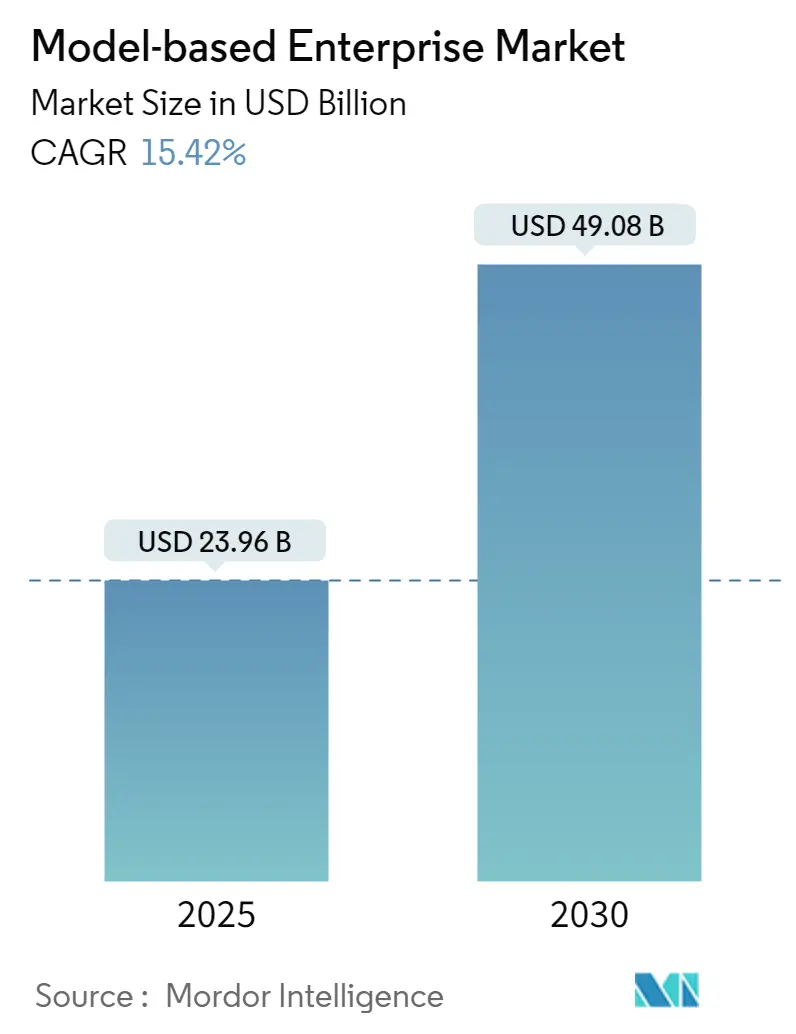
| Study Period | 2019 - 2030 |
| Market Size (2025) | USD 23.96 Billion |
| Market Size (2030) | USD 49.08 Billion |
| CAGR (2025 - 2030) | 15.42 % |
| Fastest Growing Market | Asia Pacific |
| Largest Market | North America |
| Market Concentration | Low |
Major Players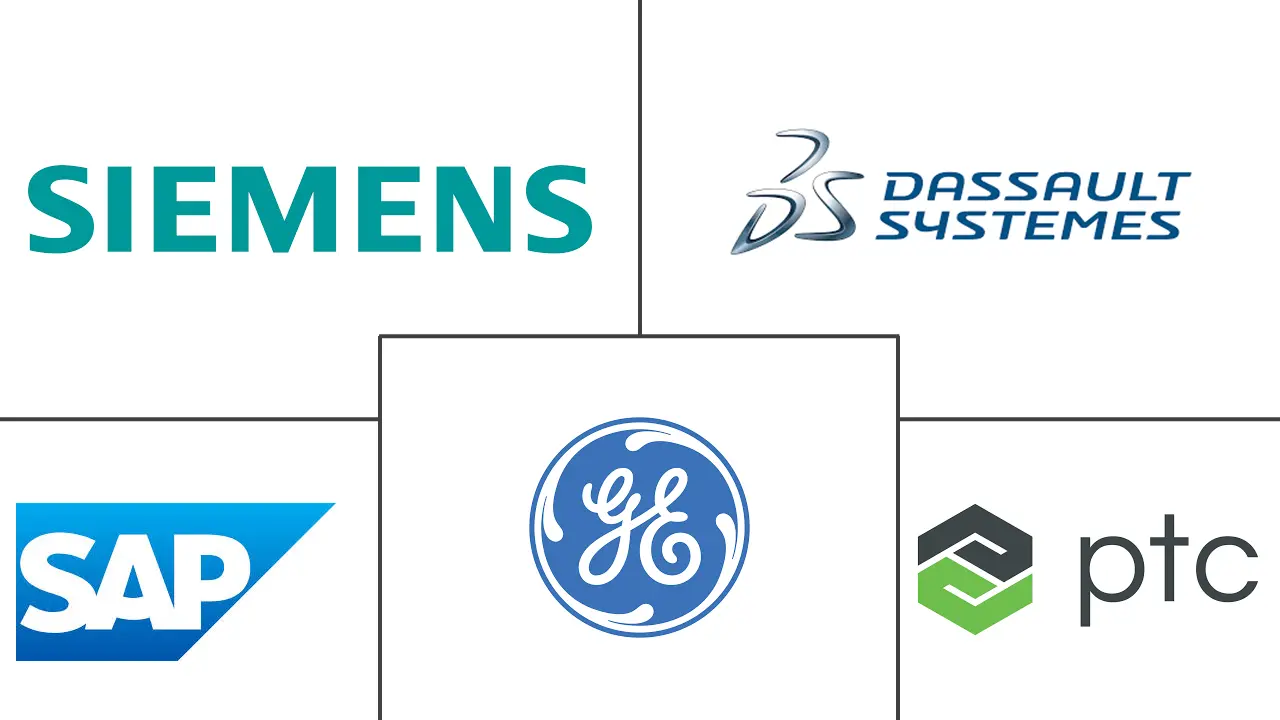
*Disclaimer: Major Players sorted in no particular order |
Model-Based Enterprise Market Analysis
The Model-based Enterprise Market size is estimated at USD 23.96 billion in 2025, and is expected to reach USD 49.08 billion by 2030, at a CAGR of 15.42% during the forecast period (2025-2030).
The model-based enterprise landscape is experiencing significant transformation amid broader industrial digital transformation trends and economic developments. According to World Bank estimates, North American GDP reached USD 32.32 trillion in 2023, with a projected growth of 1.5% in 2023-24, indicating a favorable environment for digital transformation investments. This economic backdrop has encouraged industries to transition from traditional manufacturing approaches to more sophisticated, data-driven methodologies. The consumer product manufacturing sector is notably shifting from mass production to mass customization, requiring enhanced sophistication in design and delivery processes. This transformation necessitates comprehensive data analysis capabilities and advanced modeling solutions to meet evolving market demands.
The automotive sector's embrace of model-based enterprise solutions exemplifies the broader industrial adoption trends. According to the European Automobile Manufacturers' Association (ACEA), global motor vehicle production reached 85.4 million units in 2022, marking a 5.7% increase from the previous year. The industry witnessed further growth in 2023, with new car registrations increasing by 13.9% and commercial vehicle registrations rising by 14.6%. This growth has been accompanied by increased implementation of 3D modeling and virtual product development, enabling manufacturers to enhance design efficiency, improve quality, and reduce costs across their operations.
Strategic partnerships and technological integrations are reshaping the competitive landscape. In February 2024, Dassault Systèmes announced a significant collaboration with Italian construction engineering firm VLP and Partners, implementing cloud-based 3D modeling solutions for complex architectural projects. Similarly, in September 2023, Tech Soft 3D's partnership with iBase-t marked a crucial development in enabling discrete manufacturers to collaborate on 3D digital models across various CAD formats. These collaborations demonstrate the industry's movement toward more integrated and sophisticated modeling solutions, aligning with Industry 4.0 principles.
The adoption of cloud-based solutions continues to accelerate across the industry, driven by the need for enhanced flexibility and collaborative capabilities. According to Flexera's State of the Cloud Report 2023, the adoption of single public cloud solutions increased to 11% from 9% in 2022, reflecting growing confidence in cloud-based platforms. This trend is further evidenced by recent strategic moves, such as the January 2024 partnership between Lockheed Martin Corporation and SAP SE, which aims to transform mission-critical business systems through model-based initiatives spanning the complete product value chain. These developments highlight the industry's progression toward more connected, data-driven, and collaborative approaches to product development and manufacturing, embracing digital twin and PLM technologies.
Model-Based Enterprise Market Trends
Evolving Software Capabilities
The model-based enterprise market is experiencing significant growth driven by rapid advancements in software capabilities that enable organizations to create, manage, and utilize digital models throughout the product lifecycle. Modern manufacturing facilities are increasingly relying on sophisticated software solutions that combine computer-aided design (CAD), product lifecycle management (PLM), and model-based definition (MBD) capabilities. For instance, in February 2024, Autodesk launched its Informed Design solution, a cloud-based platform that connects design and manufacturing workflows to streamline the building design and construction process, allowing architects to work with customizable, pre-defined building products. Similarly, in September 2023, Tech Soft 3D integrated its HOOPS Exchange CAD import and export library into iBase-t's Solumina iSeries Manufacturing Operations Platform, enabling discrete manufacturers to collaborate on 3D digital models and designs in virtually any CAD format.
The software evolution in the model-based enterprise space has led to the development of more sophisticated digital twin capabilities and automated model-based definition authoring. These advanced features are transforming how organizations approach product development and manufacturing processes. For example, Siemens Digital Industries Software has integrated topology optimization design capabilities with automated PMI generation in its latest NX software release, enabling seamless workflow from requirements through component generation, additive manufacturing, and final machining. The integration of artificial intelligence and machine learning algorithms into these software platforms has further enhanced their capabilities, enabling features such as automated design optimization, predictive maintenance, and real-time decision support. These technological advancements are particularly evident in the automotive sector, where manufacturers are transitioning from traditional 2D drawings to comprehensive 3D model-based definitions as the master design authority.
Rising Adoption of IoT and Cloud-based Platforms
The increasing integration of Internet of Things (IoT) and cloud-based platforms is fundamentally transforming the model-based enterprise landscape by enabling real-time data collection, analysis, and collaboration across the extended enterprise. In October 2023, T-Systems announced the provision of a cloud platform for customers interested in Omniverse digital twin technology, facilitating complex 3D pipelines and Universal Scene Description applications for industrial digitalization. This development has attracted major automotive manufacturers, with companies like Mercedes-Benz and BMW implementing the technology for their digitalization initiatives. Additionally, in February 2024, Dassault Systèmes' collaboration with Italian construction engineering firm VLP and Partners demonstrated how cloud-based platforms provide stakeholders with greater flexibility and real-time access to construction data in the context of 3D models, enabling complex surface design with improved accuracy.
The convergence of IoT and cloud technologies is enabling organizations to create more sophisticated digital twins and implement comprehensive model-based enterprise strategies. For instance, Intel's collaboration with the city of San Jose, California, to implement its IoT Smart City Demonstration Platform showcases how model-based enterprise solutions can be integrated with IoT infrastructure to support sustainable urban development initiatives. The adoption of these technologies is further accelerated by the development of 5G networks and edge computing capabilities, which enable near real-time spatial data processing and visualization. This is evidenced by recent implementations such as Ericsson's 5G radio equipment manufacturing plant in Penang, Malaysia, which demonstrates the potential of connected model-based enterprise solutions while fully embracing Industry 4.0 principles through the integration of IoT and cloud technologies.
Segment Analysis: By Offering
Solutions Segment in Model-based Enterprise Market
The solutions segment dominates the model-based enterprise market, commanding approximately 76% market share in 2024. This segment includes model-based design (MBD) tools used by end users for adopting the MBE strategy throughout the enterprise. The significant market share can be attributed to the increasing adoption of data intelligence solutions that include insight engines. The solution segment's prominence is driven by the growing need for companies to trust accurate and controlled data for a more collaborative approach to product development. Using an MBD approach allows users across organizations to virtually see the full product potential in simulation software before prototyping or manufacturing, making it an essential component for modern enterprises transitioning to digital environments.
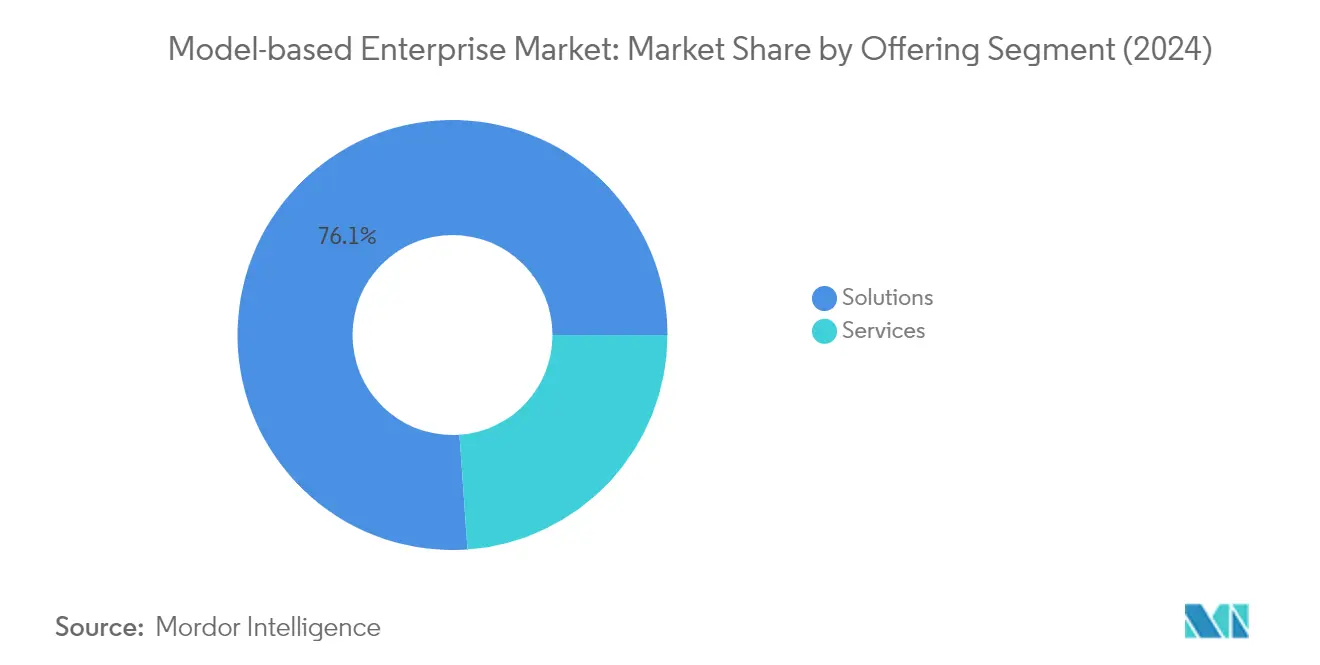
Services Segment in Model-based Enterprise Market
The services segment is emerging as the fastest-growing segment in the model-based enterprise market, projected to grow at approximately 17% during the forecast period 2024-2029. This robust growth is driven by the increasing demand for consulting, integration, and other services that enable efficient processes, intelligent networks, and cross-area optimization. The segment encompasses various types of services, including consulting services, support and maintenance, and deployment and integration, offered both as standalone services and integrated with product offerings as add-ons. Market vendors are actively assisting their customers in their MBD/MBE transformational journey by assessing their maturity, recommending appropriate strategies, and aligning roadmaps to business goals like faster time-to-market and improved contribution margins.
Segment Analysis: By Deployment Mode
Cloud Segment in Model-based Enterprise Market
The cloud segment dominates the model-based enterprise market, commanding approximately 66% of the market share in 2024, driven by its ability to provide newfound flexibility and cost advantages for enterprises. Cloud computing has gained significant traction among organizations due to its time and cost-saving benefits, along with improved agility and scalability features. The segment is experiencing the highest growth rate with a projected growth of nearly 17% during 2024-2029, as businesses increasingly recognize the advantages of cloud-based deployments. This growth is further accelerated by the integration of advanced technologies such as artificial intelligence, natural language processing, and digital thread capabilities in cloud-based MBE solutions. Major market players are actively expanding their cloud offerings, with vendors implementing robust enterprise security protocols that provide the flexibility to connect and index content both within and beyond organizations' internal data sources. The segment's growth is also supported by the increasing adoption of cloud-native solutions that enable manufacturers to be immediately operational without requiring physical IT infrastructure.
On-premise Segment in Model-based Enterprise Market
The on-premise deployment segment continues to maintain its significance in the model-based enterprise market, particularly in highly regulated industries where data security and compliance requirements necessitate local infrastructure control. This deployment mode involves installing solutions on companies' own servers, providing enhanced protection compared to cloud computing infrastructure. Organizations in sectors with strict data privacy regulations often prefer on-premise solutions due to specific requirements for local data storage and direct infrastructure ownership. The segment's value proposition is further strengthened by its ability to offer greater control over data security, customization capabilities, and compliance management. However, organizations must consider the higher costs associated with managing and maintaining on-premise solutions, including server hardware, software licenses, integration capabilities, and dedicated IT staff. Despite these challenges, the segment remains crucial for enterprises requiring maximum control over their data and infrastructure, particularly in industries with stringent security and regulatory requirements.
Segment Analysis: By End User
Automotive Segment in Model-based Enterprise Market
The automotive segment maintains its position as the dominant force in the model-based enterprise market, commanding approximately 22% market share in 2024. This leadership position is driven by the automotive industry's early adoption and promotion of model-based systems technology on a broad scale, producing some of the most advanced prototypes and products. The segment's prominence is further reinforced by the presence of major automotive manufacturers who are increasingly transitioning from traditional 2D drawings to 3D model-centric approaches. Modern automotive facilities are leveraging these advanced technologies to produce high-quality products at a faster rate with lower costs, while the integration of computer-aided design (CAD) and 3D models has become the industry standard for designing products, tooling, and manufacturing processes. The automotive sector's dominance is also attributed to the growing demand for personalized products, high-quality standards, and the need for reduced operating costs, prompting manufacturers to adopt technology and improve their business processes.
Retail Segment in Model-based Enterprise Market
The retail segment is emerging as the fastest-growing sector in the model-based enterprise market, with a projected growth rate of approximately 17% during the forecast period 2024-2029. This remarkable growth is primarily driven by the booming online retail industry's revolution through high-performance technology implementation and high-render 3D graphics models. The segment's rapid expansion is further fueled by the rollout of affordable 3D scanners, smartphones equipped with augmented reality capabilities, and significant advances in 3D imaging technology. The retail sector is witnessing increased adoption of digital twins for products, with retailers creating and presenting 3D models on their websites to enhance customer experience. The growing interest in virtual retail venues and AR/VR shopping experiences among customers is propelling the segment's growth, as firms improve simple 3D modeling merchandise and develop products that allow clients to create their metaverses and potentially recreate the social experience of in-person shopping.
Remaining Segments in End User Segmentation
The model-based enterprise market encompasses several other significant segments including aerospace and defense, construction, and power and energy sectors. The aerospace and defense segment is characterized by its emphasis on real-time collaborative process flow development and virtual product simulation capabilities. The construction segment leverages 3D modeling for creating complex building structures and improving lead times, cost efficiency, and safety measures. The power and energy sector is witnessing increased adoption of enterprise modeling solutions for transitioning to renewable and sustainable power sources, while managing highly volatile market conditions and regulatory pressures. Each of these segments contributes uniquely to the market's growth by implementing specialized applications of model-based enterprise solutions tailored to their specific industry requirements and challenges.
Model-based Enterprise Market Geography Segment Analysis
Model-based Enterprise Market in North America
North America continues to dominate the global model-based enterprise market, commanding approximately 37% market share in 2024. The region's leadership position is primarily driven by the presence of major industry players like GE, PTC, Autodesk, and Aras, who are actively focusing on strengthening their market positions through innovative solutions. The Digital Manufacturing and Design Innovation Institute (DMDII) plays a crucial role in transforming the North American manufacturing sector by supporting organizations in their digital transformation journey. Modern manufacturing facilities in the United States are increasingly relying on newer technologies and innovations to produce high-quality products at lower costs. The National Institute of Standards and Technology (NIST) actively promotes U.S. innovation and industrial competitiveness through various initiatives and summits focused on model-based enterprise implementation. The solution segment in the region is witnessing robust growth, particularly driven by its adoption in smart city projects and Industry 4.0 initiatives. Canada's commitment to implementing Industry 4.0, with ambitious goals to increase manufacturing sales, further strengthens the regional market dynamics.
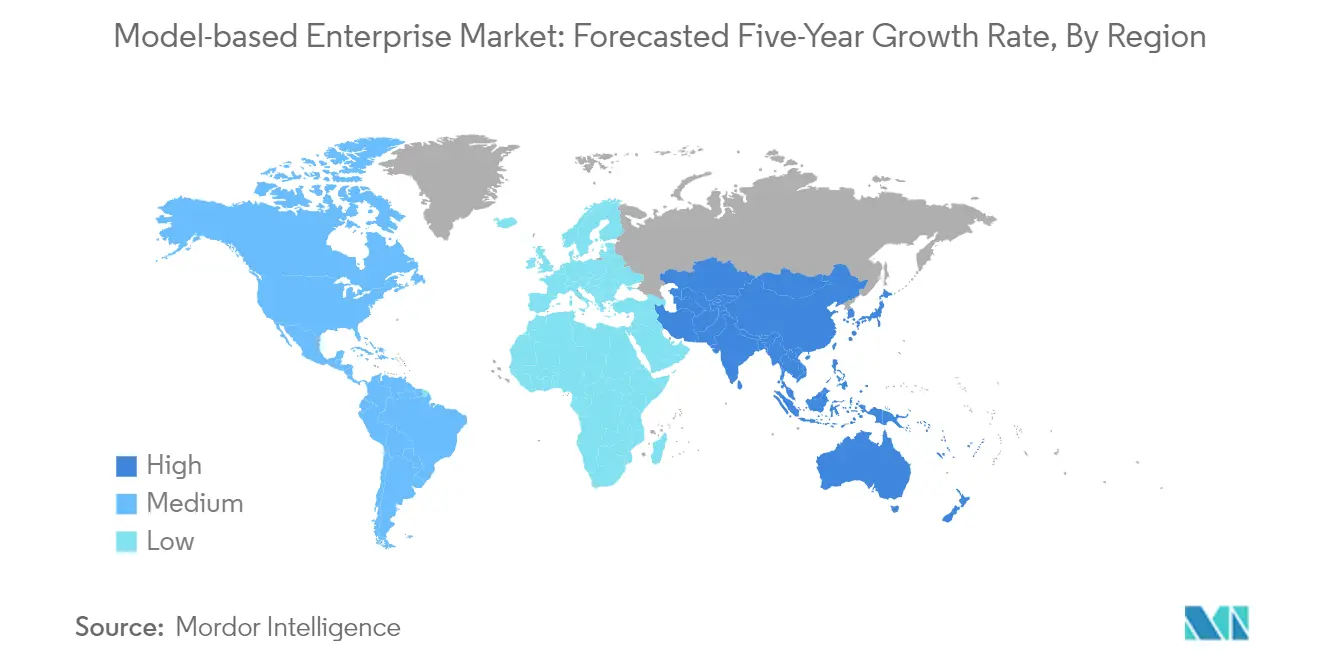
Model-based Enterprise Market in Europe
The European model-based enterprise market has demonstrated remarkable growth, with an estimated growth rate of around 15% during the period 2019-2024. The region's market is characterized by strong government support for digital transformation initiatives, with substantial investments in policies aimed at improving international competitiveness and workforce upskilling. European governments are actively funding research and development programs for innovation, with Digital Innovation Hubs being launched to support companies and enable product testing. Germany, as one of the prominent countries in the region, leads the digital transformation wave, followed by France, the United Kingdom, and Italy. The region's industrial automation landscape, coupled with high internet penetration, creates a robust ecosystem for model-based enterprise solutions. European manufacturers are increasingly adopting cloud-based solutions and digital twin technologies to enhance their operational efficiency. The strong presence of key industry players and the region's focus on Industry 4.0 initiatives continues to drive market growth.
Model-based Enterprise Market in Asia-Pacific
The Asia-Pacific model-based enterprise market is positioned for exceptional growth, with a projected CAGR of approximately 17% during 2024-2029. Countries like China, Japan, India, and South Korea are at the forefront of technological adoption in the region. Government initiatives such as "Made in China 2025" and "Made in India" are significantly boosting the manufacturing sector's digital transformation. The region is witnessing a growing trend in the adoption of 5G, Mobile Edge Computing (MEC), and IoT sensors, particularly in the implementation of digital twins. The increasing focus on smart manufacturing and Industry 4.0 initiatives is driving the demand for model-based enterprise solutions. Local players are actively entering the market, especially in India, creating a competitive landscape. The integration of advanced technologies in manufacturing processes, coupled with government support for digital transformation, positions Asia-Pacific as a key growth driver in the global market.
Model-based Enterprise Market in Latin America
Latin America's model-based enterprise market is experiencing significant transformation as enterprises make substantial shifts toward automation and digitalization. Countries like Mexico, Brazil, Colombia, and Chile are making notable investments in industrial automation, creating a robust foundation for market growth. The region's automated manufacturing ecosystem is emerging strongly, with large companies implementing MBE solutions to address critical issues in product manufacturing. The automotive sector, particularly in Mexico and Brazil, plays a pivotal role in driving market growth. The region's focus on implementing Industry 4.0 technologies and incorporating advanced manufacturing processes is creating new opportunities for market expansion. Strategic programs across logistics, solar energy, smart industries, and advanced manufacturing are fostering the adoption of MBE solutions across various sectors.
Model-based Enterprise Market in Middle East & Africa
The Middle East & Africa region is witnessing a progressive evolution in its model-based enterprise market landscape, driven by ambitious digital transformation initiatives. Countries like the UAE, Saudi Arabia, and South Africa are leading the adoption of advanced manufacturing technologies and Industry 4.0 solutions. The region's focus on smart manufacturing projects, particularly in Abu Dhabi and Saudi Arabia, is creating new opportunities for market growth. The implementation of industrial automation across various sectors is fostering the adoption of model-based enterprise solutions. Saudi Arabia's Vision 2030 and similar initiatives across the region are providing strong support for digital transformation in manufacturing industries. The African digital economy's growth potential, coupled with increasing investments in technological infrastructure, is creating favorable conditions for market expansion. The region's commitment to implementing advanced technologies and digital solutions is expected to drive sustained growth in the model-based enterprise market.
Model-Based Enterprise Industry Overview
Top Companies in Model-Based Enterprise Market
The model-based enterprise market features prominent players, including Siemens AG, General Electric, PTC Inc., Dassault Systèmes SE, SAP SE, Autodesk Inc., HCL Technologies, Oracle Corporation, Aras Corporation, and Anark Corporation. These companies are actively investing in research and development to enhance their product portfolios through cloud integration, AI capabilities, and advanced visualization features. The competitive landscape is characterized by strategic partnerships aimed at developing integrated software solutions for systems engineering, service lifecycle management, and asset management. Companies are focusing on expanding their digital offerings while incorporating emerging technologies like digital twin, IoT connectivity, and augmented reality. Market leaders are prioritizing innovation in areas such as automated model-based definition authoring, topology optimization, and cross-platform compatibility to maintain their competitive edge.
Global Leaders Dominate Through Strategic Integration
The model-based enterprise market exhibits a relatively consolidated structure dominated by large multinational technology corporations with diverse product portfolios. These established players leverage their extensive research capabilities, global presence, and strong customer relationships to maintain market leadership. The market is characterized by a mix of pure-play software providers and diversified technology conglomerates, with the latter holding significant advantages through their integrated enterprise solutions and cross-selling opportunities. Companies are actively pursuing strategic acquisitions to enhance their technological capabilities, expand geographic reach, and strengthen their position in specific industry verticals.
The competitive dynamics are shaped by increasing collaboration between software providers and industry-specific solution developers, creating comprehensive offerings that address the entire product lifecycle management. Market participants are forming strategic alliances to combine complementary strengths, particularly in areas such as cloud computing, artificial intelligence, and digital twin technologies. The landscape is evolving with the entry of specialized providers focusing on specific industry verticals or technological niches, though they face significant barriers in competing with established players' comprehensive solution suites.
Innovation and Integration Drive Market Success
Success in the model-based enterprise market increasingly depends on providers' ability to deliver comprehensive, integrated solutions that seamlessly connect with existing enterprise systems. Companies must focus on developing user-friendly interfaces, robust security features, and scalable architectures while maintaining compatibility with various data formats and industry standards. Market leaders are strengthening their positions by investing in cloud-native solutions, expanding their partner ecosystems, and developing industry-specific expertise. The ability to provide end-to-end solutions, from design and simulation to manufacturing and maintenance, while incorporating emerging technologies like AI and IoT, has become crucial for maintaining competitive advantage.
For new entrants and smaller players, success lies in identifying and serving underserved market segments or developing specialized solutions for specific industry verticals. Companies must focus on building strong relationships with system integrators and value-added resellers to expand their market reach. The increasing emphasis on sustainability and regulatory compliance creates opportunities for providers to differentiate themselves through specialized features and capabilities. Market participants must also consider the growing importance of customer support, training services, and continuous product enhancement to maintain long-term relationships with clients and protect against competitive pressures. Additionally, the integration of enterprise architecture and smart manufacturing processes is becoming increasingly vital for achieving digital transformation in the industry.
Model-Based Enterprise Market Leaders
-
Siemens AG
-
General Electric Company
-
PTC Inc.
-
Dassault Systèmes SE
-
SAP SE
- *Disclaimer: Major Players sorted in no particular order
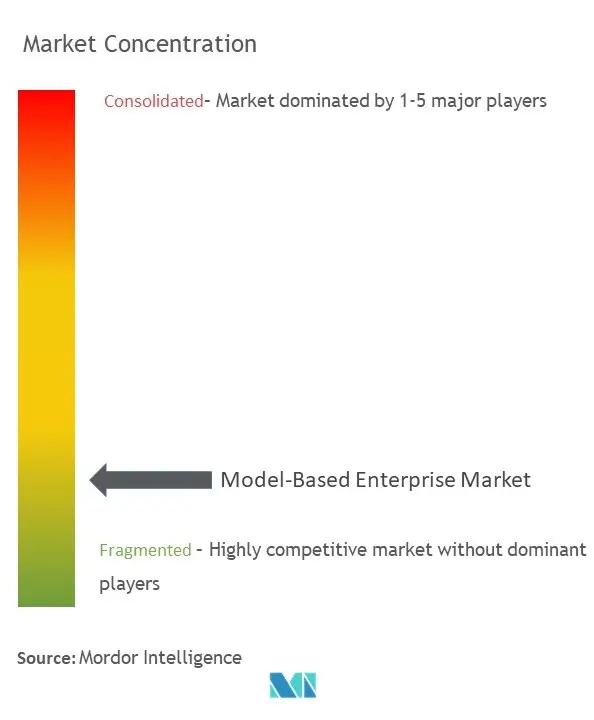
Model-Based Enterprise Market News
- September 2023 - Tech Soft 3D, the provider of engineering software development toolkits, introduced iBase-t, which assists its users in simplifying how complex products are built and maintained. It integrated HOOPS Exchange, the CAD import and export library, into iBase-t's Solumina iSeries Manufacturing Operations Platform.
- May 2023 - Agacad, the Lithuania-based developer of advanced technologies for creating information modeling and management (BIM), acquired SBS Group, a Lithuanian software creator mainly specializing in quantification, budgeting, and project management tools for construction and engineering. The acquisition expanded its broad range of 3D design and data management solutions with proven tools for the fourth and fifth dimensions of BIM time (project planning) and costs.
Model-Based Enterprise Market Report - Table of Contents
1. INTRODUCTION
- 1.1 Study Assumptions and Market Definition
- 1.2 Scope of the Study
2. RESEARCH METHODOLOGY
3. EXECUTIVE SUMMARY
4. MARKET INSIGHTS
- 4.1 Market Overview
-
4.2 Industry Attractiveness - Porter's Five Forces Analysis
- 4.2.1 Threat of New Entrants
- 4.2.2 Bargaining Power of Buyers/Consumers
- 4.2.3 Bargaining Power of Suppliers
- 4.2.4 Threat of Substitute Products
- 4.2.5 Intensity of Competitive Rivalry
- 4.3 Assessment of Macroeconomic Factors on the Market
5. MARKET DYNAMICS
-
5.1 Market Drivers
- 5.1.1 Evolving Software Capabilities
- 5.1.2 Rising Adoption of IoT and Cloud-based Platforms
-
5.2 Market Restraints
- 5.2.1 Shortage of Skilled Workers, Data Security Concerns, and the Initial Investment Costs Hinder Business Operations
6. MARKET SEGMENTATION
-
6.1 By Offering
- 6.1.1 Solutions
- 6.1.2 Services
-
6.2 By Deployment Mode
- 6.2.1 On-premise
- 6.2.2 Cloud
-
6.3 By End User
- 6.3.1 Aerospace and Defense
- 6.3.2 Automotive
- 6.3.3 Construction
- 6.3.4 Power and Energy
- 6.3.5 Retail
- 6.3.6 Other End Users
-
6.4 By Geography
- 6.4.1 North America
- 6.4.2 Europe
- 6.4.3 Asia-Pacific
- 6.4.4 Latin America
- 6.4.5 Middle East and Africa
7. COMPETITIVE LANDSCAPE
-
7.1 Company Profiles*
- 7.1.1 Siemens AG
- 7.1.2 General Electric Company
- 7.1.3 PTC Inc.
- 7.1.4 Dassault Systèmes SE
- 7.1.5 SAP SE
- 7.1.6 Autodesk Inc.
- 7.1.7 HCL Technologies Limited
- 7.1.8 Oracle Corporation
- 7.1.9 Aras Corporation
- 7.1.10 Anark Corporation
8. INVESTMENT ANALYSIS
9. MARKET OPPORTUNITIES AND FUTURE TRENDS
Model-Based Enterprise Industry Segmentation
Model-based enterprise (MBE) is an engineering strategy that primarily aims to clarify the design intent during the manufacturing process by using a 3D model-based definition that includes all the product and manufacturing process information associated with the product's manufacturing.
The model-based enterprise market is segmented by offering (solutions and services), deployment mode (on-premise and cloud), end user (aerospace and defense, automotive, construction, power and energy, retail, and other end users), and geography (North America, Europe, Asia-Pacific, Latin America, and Middle East and Africa). The market size and forecasts are provided in terms of value in USD for all the above segments.
| By Offering | Solutions |
| Services | |
| By Deployment Mode | On-premise |
| Cloud | |
| By End User | Aerospace and Defense |
| Automotive | |
| Construction | |
| Power and Energy | |
| Retail | |
| Other End Users | |
| By Geography | North America |
| Europe | |
| Asia-Pacific | |
| Latin America | |
| Middle East and Africa |
Model-Based Enterprise Market Research FAQs
How big is the Model-based Enterprise Market?
The Model-based Enterprise Market size is expected to reach USD 23.96 billion in 2025 and grow at a CAGR of 15.42% to reach USD 49.08 billion by 2030.
What is the current Model-based Enterprise Market size?
In 2025, the Model-based Enterprise Market size is expected to reach USD 23.96 billion.
Who are the key players in Model-based Enterprise Market?
Siemens AG, General Electric Company, PTC Inc., Dassault Systèmes SE and SAP SE are the major companies operating in the Model-based Enterprise Market.
Which is the fastest growing region in Model-based Enterprise Market?
Asia Pacific is estimated to grow at the highest CAGR over the forecast period (2025-2030).
Which region has the biggest share in Model-based Enterprise Market?
In 2025, the North America accounts for the largest market share in Model-based Enterprise Market.
What years does this Model-based Enterprise Market cover, and what was the market size in 2024?
In 2024, the Model-based Enterprise Market size was estimated at USD 20.27 billion. The report covers the Model-based Enterprise Market historical market size for years: 2019, 2020, 2021, 2022, 2023 and 2024. The report also forecasts the Model-based Enterprise Market size for years: 2025, 2026, 2027, 2028, 2029 and 2030.
Our Best Selling Reports
Model-based Enterprise Market Research
Mordor Intelligence provides a comprehensive analysis of the model-based enterprise landscape. We leverage our extensive expertise in digital transformation and Industry 4.0 research. Our detailed report examines the convergence of PLM (Product Lifecycle Management) technologies with digital twin implementations, enterprise architecture, and 3D modeling solutions. This analysis includes crucial developments in MBSE (Model-Based Systems Engineering), computer-aided design, and smart manufacturing trends. The report is available in an easy-to-download PDF format.
Stakeholders gain valuable insights into digital manufacturing processes, manufacturing execution system implementations, and digital thread integration strategies. The report explores the evolution of manufacturing automation alongside industrial digitalization trends, providing actionable intelligence for decision-makers. Our analysis covers product data management solutions, computer-aided manufacturing advancements, and enterprise modeling frameworks. This offers a comprehensive view of how digital enterprise initiatives are reshaping industrial operations. The report particularly emphasizes the role of model-based systems engineering in driving innovation across various industry sectors.




